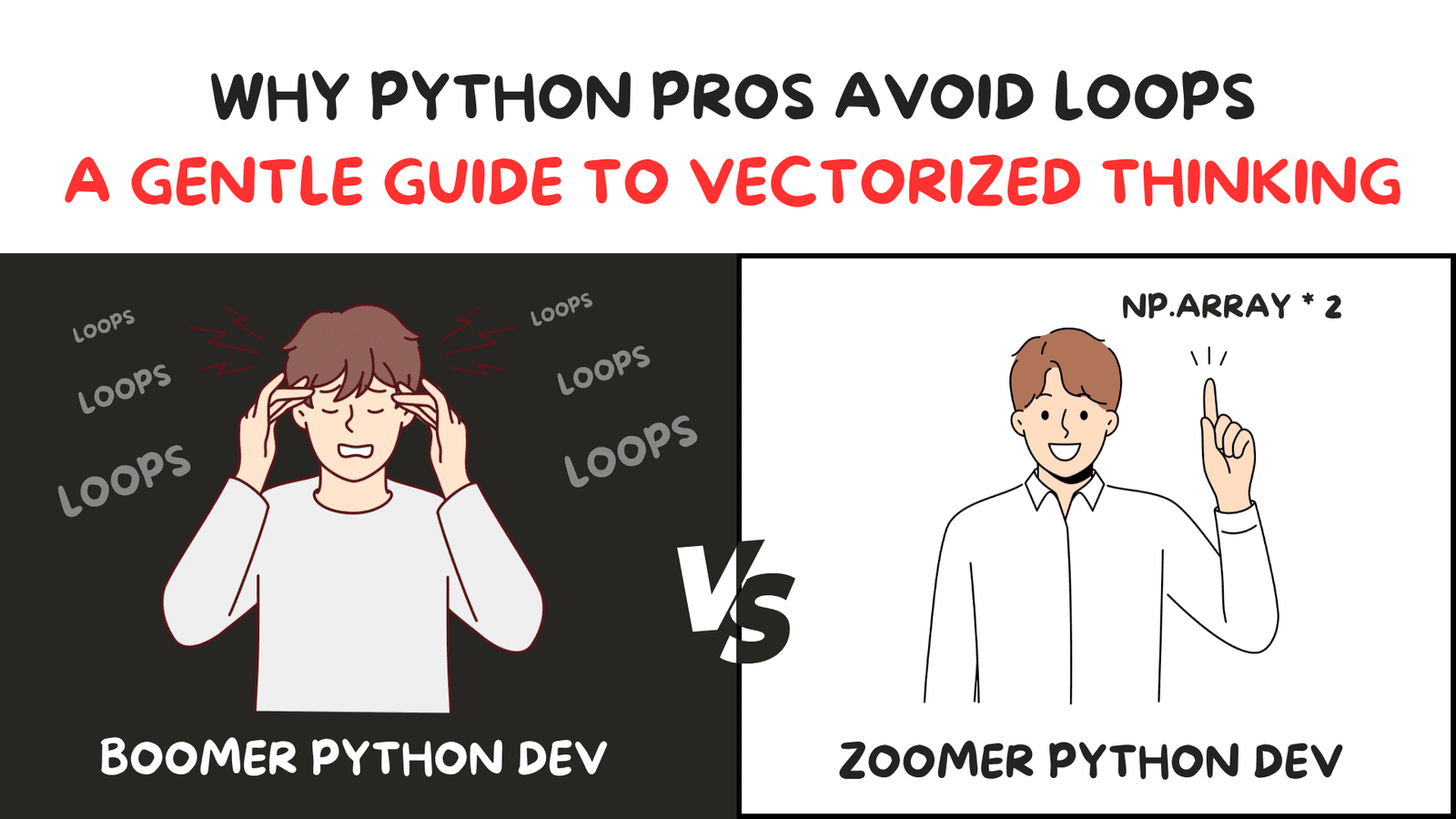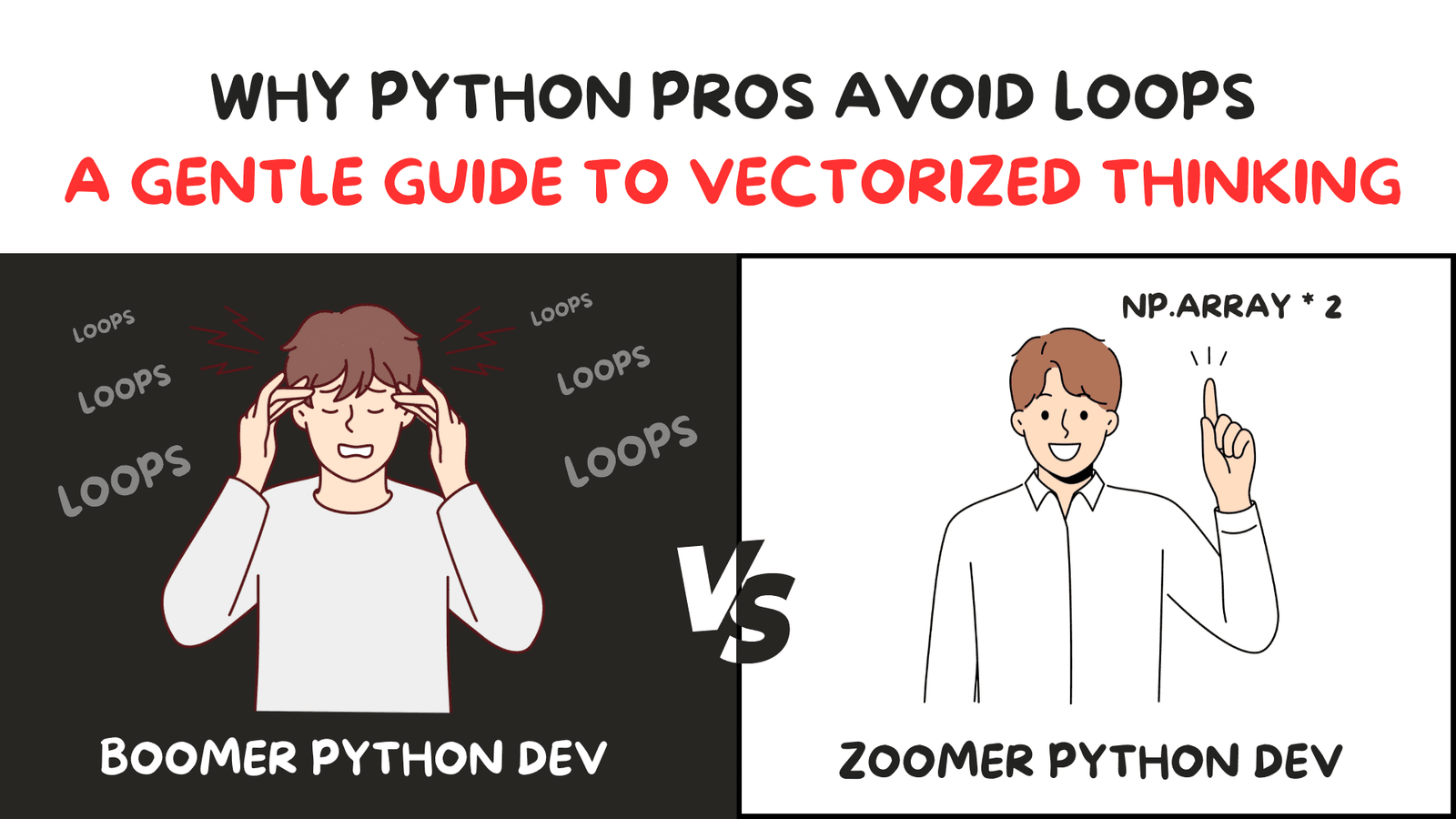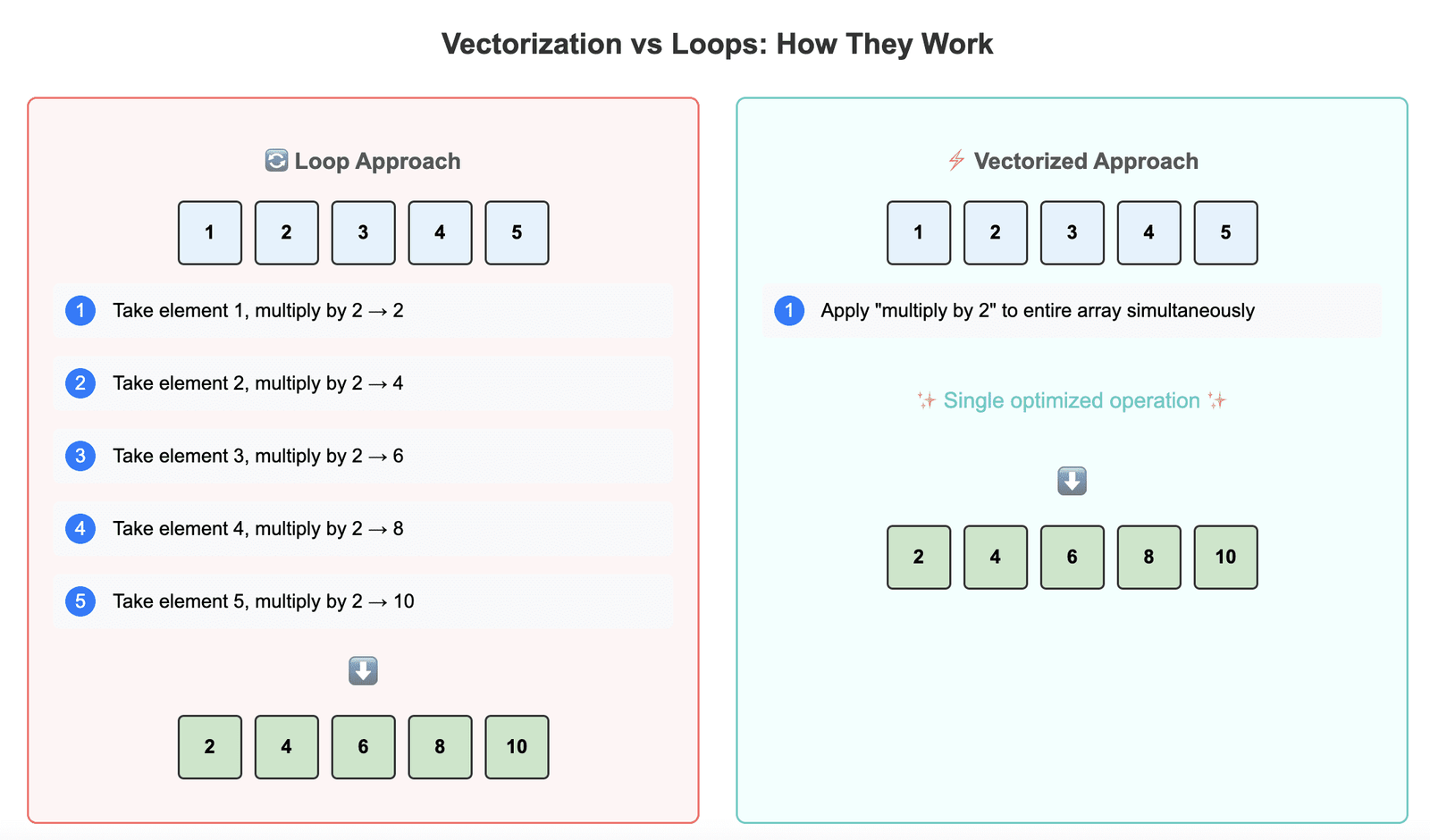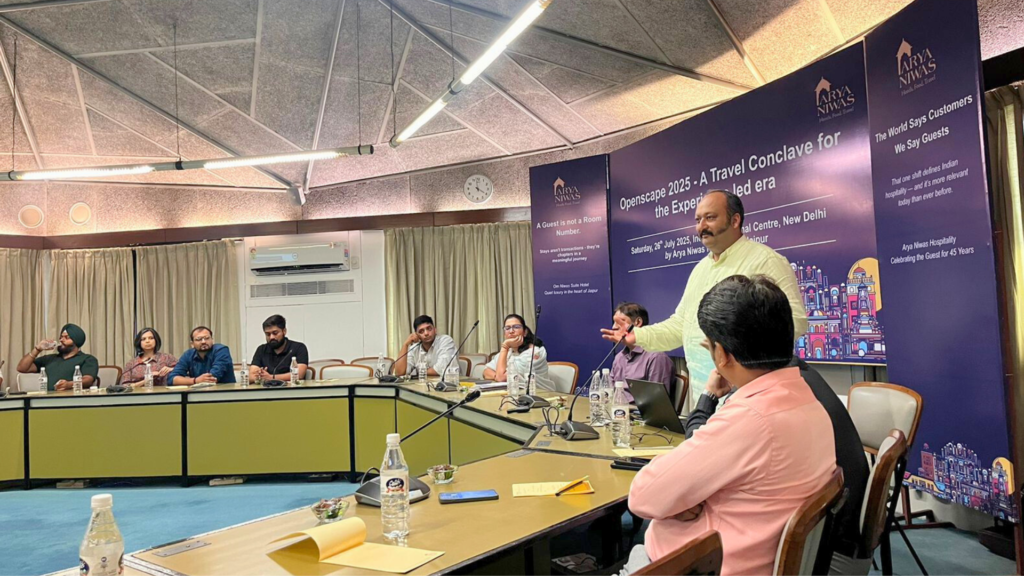AI in Travel
Why Python Pros Avoid Loops: A Gentle Guide to Vectorized Thinking


Image by Author | Canva
# Introduction
When you’re new to Python, you usually use “for” loops whenever you have to process a collection of data. Need to square a list of numbers? Loop through them. Need to filter or sum them? Loop again. This is more intuitive for us as humans because our brain thinks and works sequentially (one thing at a time).
But that doesn’t mean computers have to. They can take advantage of something called vectorized thinking. Basically, instead of looping through every element to perform an operation, you give the entire list to Python like, “Hey, here is the list. Perform all the operations at once.”
In this tutorial, I’ll give you a gentle introduction to how it works, why it matters, and we’ll also cover a few examples to see how beneficial it can be. So, let’s get started.
# What is Vectorized Thinking & Why It Matters?
As discussed previously, vectorized thinking means that instead of handling operations sequentially, we want to perform them collectively. This idea is actually inspired by matrix and vector operations in mathematics, and it makes your code much faster and more readable. Libraries like NumPy allow you to implement vectorized thinking in Python.
For example, if you have to multiply a list of numbers by 2, then instead of accessing every element and doing the operation one by one, you multiply the entire list simultaneously. This has major benefits, like reducing much of Python’s overhead. Every time you iterate through a Python loop, the interpreter has to do a lot of work like checking the types, managing objects, and handling loop mechanics. With a vectorized approach, you reduce that by processing in bulk. It’s also much faster. We’ll see that later with an example for performance impact. I’ve visualized what I just said in the form of an image so you can get an idea of what I’m referring to.


Now that you have the idea of what it is, let’s see how you can implement it and how it can be useful.
# A Simple Example: Temperature Conversion
There are different temperature conventions used in different countries. For example, if you’re familiar with the Fahrenheit scale and the data is given in Celsius, here’s how you can convert it using both approaches.
// The Loop Approach
celsius_temps = [0, 10, 20, 30, 40, 50]
fahrenheit_temps = []
for temp in celsius_temps:
fahrenheit = (temp * 9/5) + 32
fahrenheit_temps.append(fahrenheit)
print(fahrenheit_temps)
Output:
[32.0, 50.0, 68.0, 86.0, 104.0, 122.0]
// The Vectorized Approach
import numpy as np
celsius_temps = np.array([0, 10, 20, 30, 40, 50])
fahrenheit_temps = (celsius_temps * 9/5) + 32
print(fahrenheit_temps) # [32. 50. 68. 86. 104. 122.]
Output:
[ 32. 50. 68. 86. 104. 122.]
Instead of dealing with each item one at a time, we turn the list into a NumPy array and apply the formula to all elements at once. Both of them process the data and give the same result. Apart from the NumPy code being more concise, you might not notice the time difference right now. But we’ll cover that shortly.
# Advanced Example: Mathematical Operations on Multiple Arrays
Let’s take another example where we have multiple arrays and we have to calculate profit. Here’s how you can do it with both approaches.
// The Loop Approach
revenues = [1000, 1500, 800, 2000, 1200]
costs = [600, 900, 500, 1100, 700]
tax_rates = [0.15, 0.18, 0.12, 0.20, 0.16]
profits = []
for i in range(len(revenues)):
gross_profit = revenues[i] - costs[i]
net_profit = gross_profit * (1 - tax_rates[i])
profits.append(net_profit)
print(profits)
Output:
[340.0, 492.00000000000006, 264.0, 720.0, 420.0]
Here, we’re calculating profit for each entry manually:
- Subtract cost from revenue (gross profit)
- Apply tax
- Append result to a new list
Works fine, but it’s a lot of manual indexing.
// The Vectorized Approach
import numpy as np
revenues = np.array([1000, 1500, 800, 2000, 1200])
costs = np.array([600, 900, 500, 1100, 700])
tax_rates = np.array([0.15, 0.18, 0.12, 0.20, 0.16])
gross_profits = revenues - costs
net_profits = gross_profits * (1 - tax_rates)
print(net_profits)
Output:
[340. 492. 264. 720. 420.]
The vectorized version is also more readable, and it performs element-wise operations across all three arrays simultaneously. Now, I don’t just want to keep repeating “It’s faster” without solid proof. And you might be thinking, “What is Kanwal even talking about?” But now that you’ve seen how to implement it, let’s look at the performance difference between the two.
# Performance: The Numbers Don’t Lie
The difference I’m talking about isn’t just hype or some theoretical thing. It’s measurable and proven. Let’s look at a practical benchmark to understand how much improvement you can expect. We’ll create a very large dataset of 1,000,000 instances and perform the operation \( x^2 + 3x + 1 \) on each element using both approaches and compare the time.
import numpy as np
import time
# Create a large dataset
size = 1000000
data = list(range(size))
np_data = np.array(data)
# Test loop-based approach
start_time = time.time()
result_loop = []
for x in data:
result_loop.append(x ** 2 + 3 * x + 1)
loop_time = time.time() - start_time
# Test vectorized approach
start_time = time.time()
result_vector = np_data ** 2 + 3 * np_data + 1
vector_time = time.time() - start_time
print(f"Loop time: {loop_time:.4f} seconds")
print(f"Vector time: {vector_time:.4f} seconds")
print(f"Speedup: {loop_time / vector_time:.1f}x faster")
Output:
Loop time: 0.4615 seconds
Vector time: 0.0086 seconds
Speedup: 53.9x faster
That’s more than 50 times faster!!!
This isn’t a small optimization, it will make your data processing tasks (I’m talking about BIG datasets) much more feasible. I’m using NumPy for this tutorial, but Pandas is another library built on top of NumPy. You can use that too.
# When NOT to Vectorize
Just because something works for most cases doesn’t mean it’s the approach. In programming, your “best” approach always depends on the problem at hand. Vectorization is great when you’re performing the same operation on all elements of a dataset. But if your logic involves complex conditionals, early termination, or operations that depend on previous results, then stick to the loop-based approach.
Similarly, when working with very small datasets, the overhead of setting up vectorized operations might outweigh the benefits. So just use it where it makes sense, and don’t force it where it doesn’t.
# Wrapping Up
As you continue to work with Python, challenge yourself to spot opportunities for vectorization. When you find yourself reaching for a `for` loop, pause and ask whether there’s a way to express the same operation using NumPy or Pandas. More often than not, there is, and the result will be code that’s not only faster but also more elegant and easier to understand.
Remember, the goal isn’t to eliminate all loops from your code. It’s to use the right tool for the job.
Kanwal Mehreen Kanwal is a machine learning engineer and a technical writer with a profound passion for data science and the intersection of AI with medicine. She co-authored the ebook “Maximizing Productivity with ChatGPT”. As a Google Generation Scholar 2022 for APAC, she champions diversity and academic excellence. She’s also recognized as a Teradata Diversity in Tech Scholar, Mitacs Globalink Research Scholar, and Harvard WeCode Scholar. Kanwal is an ardent advocate for change, having founded FEMCodes to empower women in STEM fields.
AI in Travel
With focus on AI, sustainable travel Arya Niwas organises Openscapes 2025 in New Delhi

The opportunities and challenges that issues like artificial intelligence, sustainability and experiential travel pose to the tourism industry in India and overseas were highlighted at Openscapes 2025, a travel conclave in New Delhi on Saturday.
Organised by Arya Niwas, a hospitality group based in Jaipur, the conclave served as a participative platform to explore transformative ideas for the tourism sector, addressing pressing issues such as sustainability, experiential curation, the role of artificial intelligence (AI), and the integration of responsible practices into the travel experience.
Drawing stakeholders from across India’s hospitality industry, the conclave was organised with the core theme of Projecting India and Rajasthan with a stronger, more meaningful narrative.
“This is the first conclave. It is called Openscapes. We hope that we will be having more such dialogue-based conclaves on travel. There is a need for us to behave as one in the travel industry and to move forward together because the ultimate aim is to serve the guests and make the guests win,” Pooja Bansal, Owner and General Manager, Arya Niwas, told India & You on the sidelines of the event.
The urgency of the issues raised at the meeting was underscored by leading tour operators, who highlighted that Indian tourism, particularly in recent years, “has not been sustainable and things have gone really, really bad.”
The conclave drew stakeholders from across India’s hospitality industry
“When we talk about sustainability with experiential tourism, the experience at the grassroot level, meeting local people with a bit of sustainability, offers eye-opening encounters. Yet, there are challenges,” Navneet Arora, Managing Director, VINString Holidays, a travel agency in New Delhi, told India & You.
The meeting illustrated both obstacles and achievements in rural and urban experiential tourism. Operators cited instances where visitors’ immersion in heritage neighbourhoods and private homes fostered mutual pride among locals and tourists. However, they also warned against approaches that leave rural residents feeling like “monkeys in the zoo,” underscoring the necessity of responsible, respectful interaction, something now addressed by ensuring a share of tour proceeds benefit the communities involved. Sustainability, participants argued, extends well beyond eco-friendly rhetoric.
The conclave highlighted innovative tour formats, slow tourism, creative workshops and direct engagement with artisans, as pathways for deeper, more rewarding guest experiences.
“I think that is the call for the future, because automation has to come in. If we are not doing automation today, we are backwards. AI is important. The event opens up eyes for a lot of people. Difficult, but yes, AI and sustainability are important and doable,” Arora added.
“The interpretation of sustainability has become very cliché. This was a session to break that,” said Bansal.
Participants at the Openscapes 2025 called for a sustained dialogue, with suggestions for sector-wide conventions and targetted sessions on marketing and AI and more collaborative initiatives.
AI in Travel
Sabre Corporation’s Strategic Partnership with Christopherson Business Travel and Its Implications for Undervalued Cloud and AI Stocks

Sabre Corporation (NASDAQ: SABR) has long been a cornerstone of the global travel technology sector, but its recent strategic partnership with Christopherson Business Travel marks a pivotal evolution. By leveraging its AI-driven platform and cloud-native infrastructure, Sabre is not only modernizing corporate travel management but also positioning itself as a catalyst for growth in the undervalued travel tech sector. For investors, this collaboration offers a compelling case study in how AI and cloud innovation can unlock long-term value in a niche yet resilient market.
A Strategic Alliance for the Future of Corporate Travel
On July 17, 2025, Sabre announced a multi-year agreement to become Christopherson Business Travel’s primary technology partner. This partnership is more than a transactional arrangement—it’s a strategic alignment of two companies aiming to redefine corporate travel through automation, real-time data, and personalized service. Sabre’s AI-powered tools, including Sabre Red 360, Trip Proposal, and Market Intelligence, will streamline operations for Christopherson, enabling faster decision-making and enhanced client offerings.
The integration of Sabre’s cloud-native infrastructure into Christopherson’s proprietary Andavo platform is particularly noteworthy. This move allows for real-time orchestration of multi-source content (air, hotel, rail, ground) and seamless API-driven integrations, reducing manual effort and improving scalability. As Chad Maughan, CTO of Christopherson, noted, Sabre’s architecture provides the operational flexibility needed to adapt to evolving client demands—a critical advantage in the post-pandemic corporate travel landscape.
Sabre’s Financial Resilience and AI-Driven Growth
Sabre’s financial performance in 2024 underscores its transition from a turnaround story to a growth-oriented entity. Revenue increased to $3 billion, with adjusted EBITDA rising to $517 million—a 54% year-over-year improvement. While IT Solutions revenue dipped due to de-migrations, the Travel Solutions and Distribution segments grew by 4% and 6%, respectively, driven by demand for Sabre’s AI-powered tools.
The company’s market cap of $1.222 billion pales in comparison to AI/cloud giants like Databricks ($62 billion) or Snowflake ($43.6 billion), but this undervaluation reflects Sabre’s niche focus. Its strategic investments in Sabre Mosaic—a modular platform combining AI, cloud, and traditional agent workflows—position it to capture a larger share of the corporate travel market, which is projected to grow as businesses prioritize cost optimization and efficiency.
The AI/Cloud Travel Tech Opportunity
The broader travel tech sector is undergoing a transformation fueled by generative AI. According to Skift Research, AI-driven tools could create a $28 billion+ opportunity for the industry, with applications in personalized itineraries, dynamic pricing, and automated customer service. Sabre’s Automated Exchanges & Refunds and Agency Retailer solutions are already streamlining post-booking processes, reducing manual intervention by up to 70%.
However, Sabre is not alone in the race to monetize AI in travel. Competitors like C3.ai (NYSE: AI), Marvell Technology (NASDAQ: MRVL), and DigitalOcean (DOCN) are also leveraging cloud and AI to drive growth. C3.ai’s predictive analytics tools, for instance, have secured government contracts worth $450 million, while Marvell’s AI-optimized chips are powering data centers for hyperscale providers. Yet, Sabre’s deep vertical integration into travel-specific workflows gives it a unique edge in the corporate travel niche.
Why Sabre Is an Undervalued Investment
Despite its strategic advantages, Sabre remains overlooked by many investors. Its current price-to-earnings ratio (P/E) of 8.5 is significantly lower than the industry average of 18.5, and its hedge fund ownership (11.2%) suggests growing confidence in its AI-driven roadmap. The partnership with Christopherson is a validation of Sabre’s value proposition: it enables the company to scale its AI/Cloud offerings without overhauling existing systems, a critical factor for travel agencies seeking cost-effective modernization.
For investors, the key question is whether Sabre can replicate its success in other verticals. The company’s PowerSuite Cloud platform, which automates operations and integrates NDC content, is already gaining traction among mid-sized travel agencies. If Sabre can expand its footprint in the corporate and leisure travel markets, its revenue could outpace the 10% growth projected by analysts.
Conclusion: A Strategic Bet on AI-Driven Travel
Sabre’s partnership with Christopherson Business Travel is a microcosm of the broader shift toward AI and cloud-native solutions in travel technology. While the company may lack the valuation of tech giants like Microsoft or Google, its focus on vertical-specific innovation and operational efficiency makes it a compelling play for investors seeking exposure to the travel sector’s AI revolution.
For those considering a diversified portfolio, Sabre offers a unique blend of undervaluation and growth potential. However, it should be viewed as a complementary holding to broader AI/cloud stocks like C3.ai or Marvell, rather than a standalone bet. As the travel industry continues to embrace AI-driven automation, Sabre’s ability to deliver scalable, client-centric solutions will likely drive long-term value for both its partners and shareholders.
AI in Travel
AI Travel Tricks: Watch Out for the Road to Nowhere – Herald/Review Media

AI Travel Tricks: Watch Out for the Road to Nowhere Herald/Review Media
Source link
-

 Brand Stories6 days ago
Brand Stories6 days agoBloom Hotels: A Modern Vision of Hospitality Redefining Travel
-

 Brand Stories23 hours ago
Brand Stories23 hours agoCheQin.ai sets a new standard for hotel booking with its AI capabilities: empowering travellers to bargain, choose the best, and book with clarity.
-

 Destinations & Things To Do7 days ago
Destinations & Things To Do7 days agoUntouched Destinations: Stunning Hidden Gems You Must Visit
-

 AI in Travel7 days ago
AI in Travel7 days agoAI Travel Revolution: Must-Have Guide to the Best Experience
-

 Brand Stories3 weeks ago
Brand Stories3 weeks agoVoice AI Startup ElevenLabs Plans to Add Hubs Around the World
-

 Brand Stories2 weeks ago
Brand Stories2 weeks agoHow Elon Musk’s rogue Grok chatbot became a cautionary AI tale
-

 Asia Travel Pulse3 weeks ago
Asia Travel Pulse3 weeks agoLooking For Adventure In Asia? Here Are 7 Epic Destinations You Need To Experience At Least Once – Zee News
-

 Destinations & Things To Do19 hours ago
Destinations & Things To Do19 hours agoThis Hidden Beach in India Glows at Night-But Only in One Secret Season
-

 AI in Travel3 weeks ago
AI in Travel3 weeks ago‘Will AI take my job?’ A trip to a Beijing fortune-telling bar to see what lies ahead | China
-

 Brand Stories3 weeks ago
Brand Stories3 weeks agoChatGPT — the last of the great romantics

You must be logged in to post a comment Login